Comprehensive Stakeholder Analysis Report: Facebook Business Overview
VerifiedAdded on 2021/02/22
|8
|2111
|275
Report
AI Summary
This report provides a comprehensive stakeholder analysis of Facebook, examining key stakeholder groups and their roles within the company. The report begins with an introduction to Facebook, outlining its founding, mission, and current trends, including the rise of private communities and conversational commerce. It identifies and analyzes various stakeholder groups, including employees, owners, customers, local community organizations, government, media, and suppliers. The analysis categorizes stakeholders into defensive, offensive, swing, and hold groups, assessing their behavior based on competitive threats, corporate potential, and actual behavior. Detailed tables compare and contrast the stakeholders' aims, potential actions, and actual behaviors, highlighting the importance of customer satisfaction, employee engagement, and government regulations. The report concludes by emphasizing the dynamic nature of stakeholder relationships and the need for Facebook to adapt to changing market demands and regulatory environments.
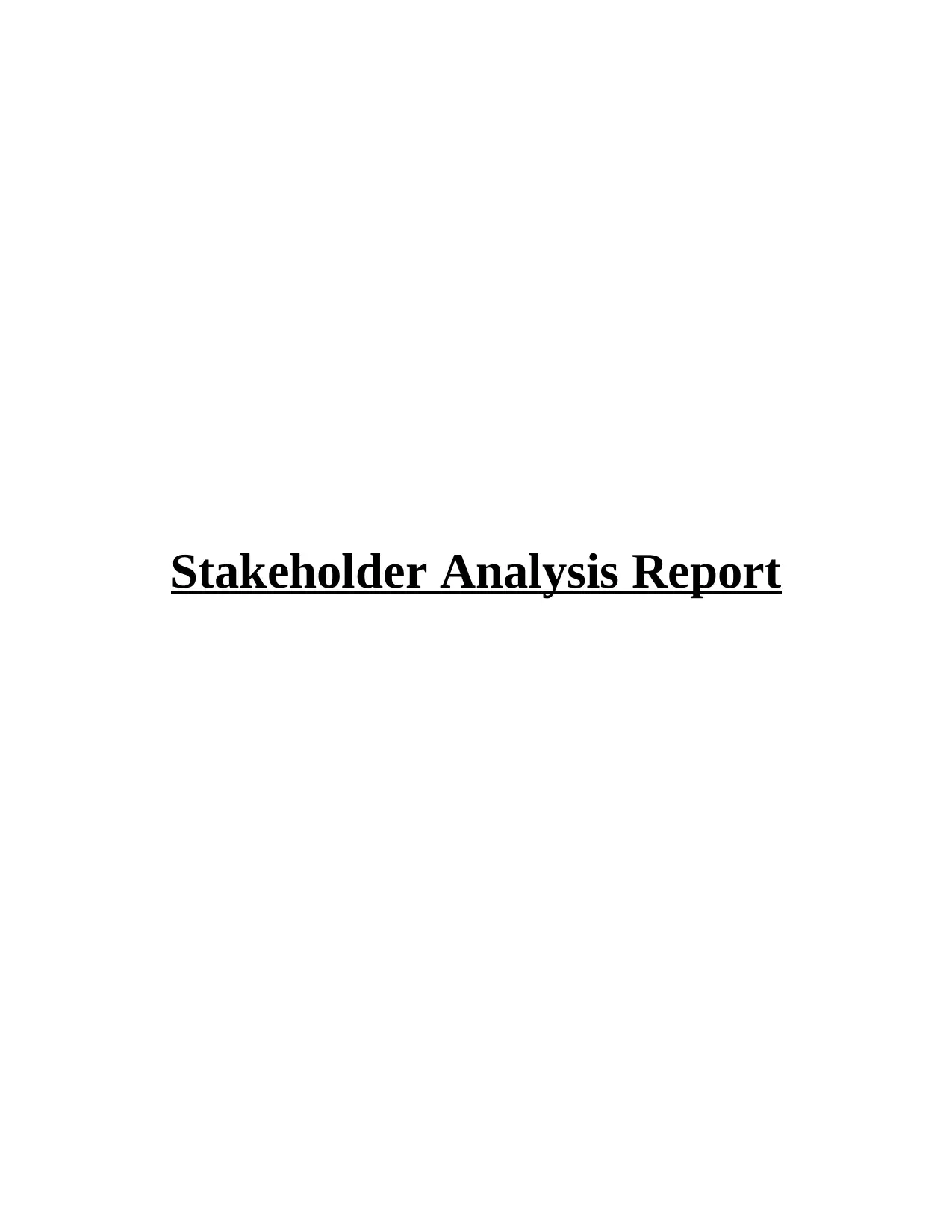
Stakeholder Analysis Report
Paraphrase This Document
Need a fresh take? Get an instant paraphrase of this document with our AI Paraphraser
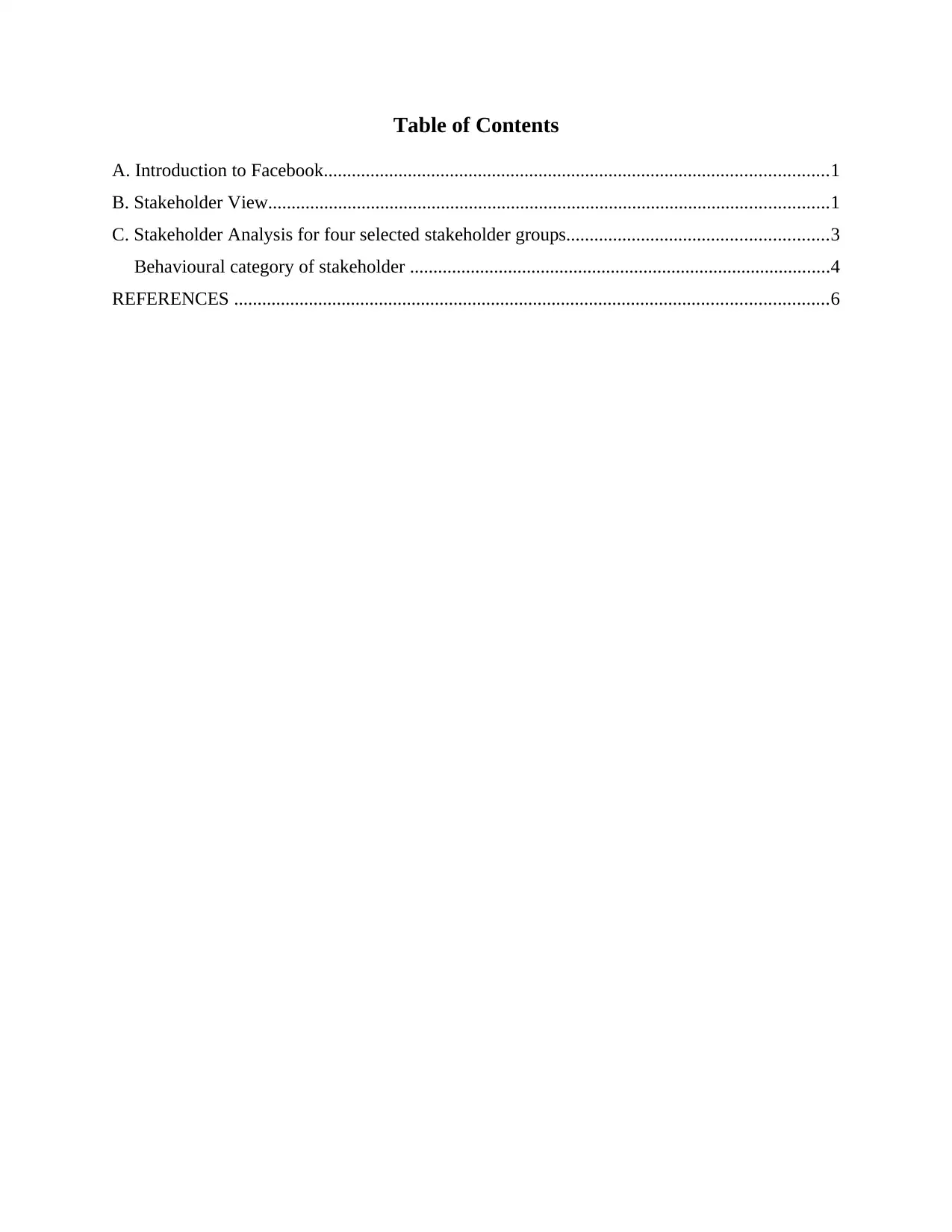
Table of Contents
A. Introduction to Facebook............................................................................................................1
B. Stakeholder View........................................................................................................................1
C. Stakeholder Analysis for four selected stakeholder groups........................................................3
Behavioural category of stakeholder ..........................................................................................4
REFERENCES ...............................................................................................................................6
A. Introduction to Facebook............................................................................................................1
B. Stakeholder View........................................................................................................................1
C. Stakeholder Analysis for four selected stakeholder groups........................................................3
Behavioural category of stakeholder ..........................................................................................4
REFERENCES ...............................................................................................................................6
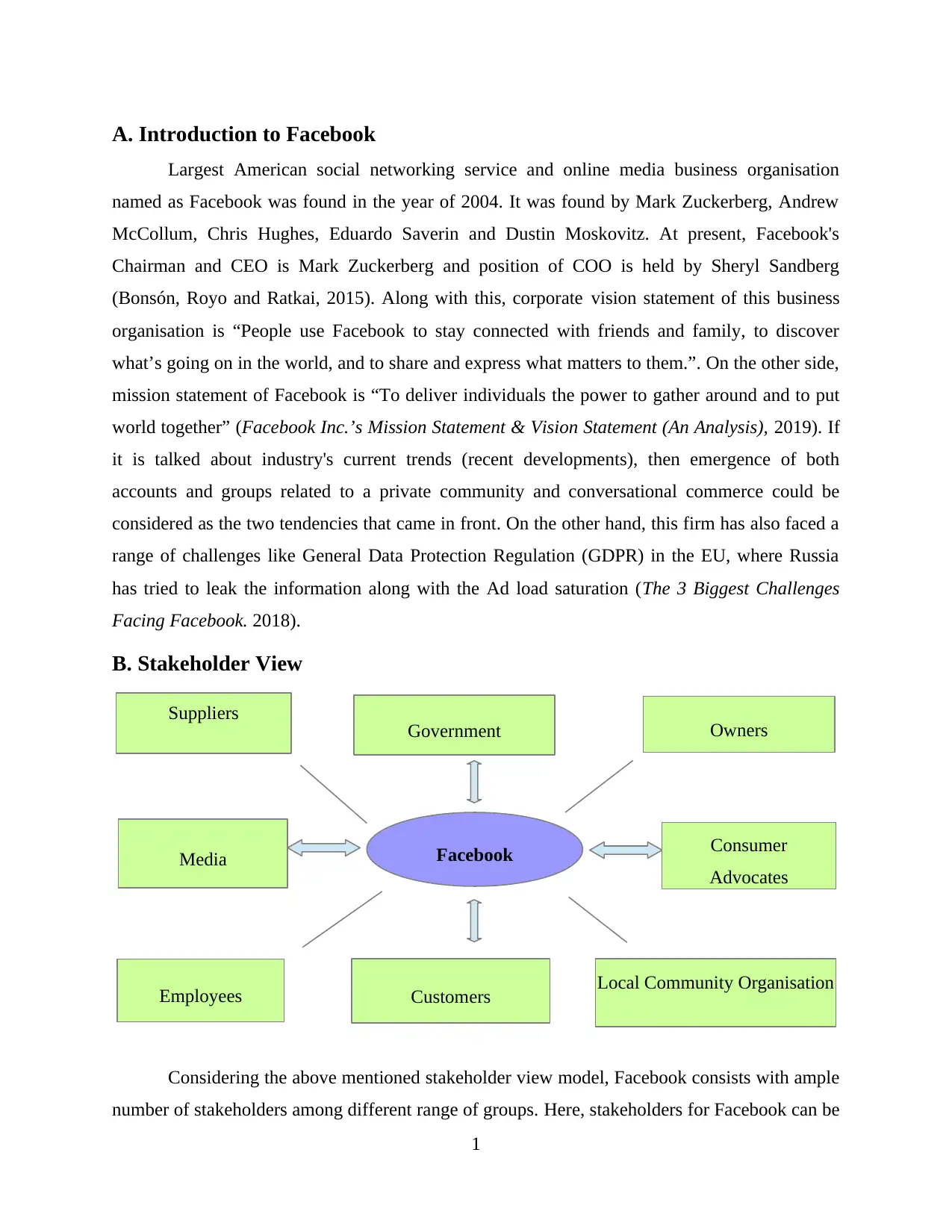
A. Introduction to Facebook
Largest American social networking service and online media business organisation
named as Facebook was found in the year of 2004. It was found by Mark Zuckerberg, Andrew
McCollum, Chris Hughes, Eduardo Saverin and Dustin Moskovitz. At present, Facebook's
Chairman and CEO is Mark Zuckerberg and position of COO is held by Sheryl Sandberg
(Bonsón, Royo and Ratkai, 2015). Along with this, corporate vision statement of this business
organisation is “People use Facebook to stay connected with friends and family, to discover
what’s going on in the world, and to share and express what matters to them.”. On the other side,
mission statement of Facebook is “To deliver individuals the power to gather around and to put
world together” (Facebook Inc.’s Mission Statement & Vision Statement (An Analysis), 2019). If
it is talked about industry's current trends (recent developments), then emergence of both
accounts and groups related to a private community and conversational commerce could be
considered as the two tendencies that came in front. On the other hand, this firm has also faced a
range of challenges like General Data Protection Regulation (GDPR) in the EU, where Russia
has tried to leak the information along with the Ad load saturation (The 3 Biggest Challenges
Facing Facebook. 2018).
B. Stakeholder View
Considering the above mentioned stakeholder view model, Facebook consists with ample
number of stakeholders among different range of groups. Here, stakeholders for Facebook can be
1
Facebook Consumer
Advocates
Customers
Government Owners
Local Community Organisation
Employees
Suppliers
Media
Largest American social networking service and online media business organisation
named as Facebook was found in the year of 2004. It was found by Mark Zuckerberg, Andrew
McCollum, Chris Hughes, Eduardo Saverin and Dustin Moskovitz. At present, Facebook's
Chairman and CEO is Mark Zuckerberg and position of COO is held by Sheryl Sandberg
(Bonsón, Royo and Ratkai, 2015). Along with this, corporate vision statement of this business
organisation is “People use Facebook to stay connected with friends and family, to discover
what’s going on in the world, and to share and express what matters to them.”. On the other side,
mission statement of Facebook is “To deliver individuals the power to gather around and to put
world together” (Facebook Inc.’s Mission Statement & Vision Statement (An Analysis), 2019). If
it is talked about industry's current trends (recent developments), then emergence of both
accounts and groups related to a private community and conversational commerce could be
considered as the two tendencies that came in front. On the other hand, this firm has also faced a
range of challenges like General Data Protection Regulation (GDPR) in the EU, where Russia
has tried to leak the information along with the Ad load saturation (The 3 Biggest Challenges
Facing Facebook. 2018).
B. Stakeholder View
Considering the above mentioned stakeholder view model, Facebook consists with ample
number of stakeholders among different range of groups. Here, stakeholders for Facebook can be
1
Facebook Consumer
Advocates
Customers
Government Owners
Local Community Organisation
Employees
Suppliers
Media
⊘ This is a preview!⊘
Do you want full access?
Subscribe today to unlock all pages.

Trusted by 1+ million students worldwide
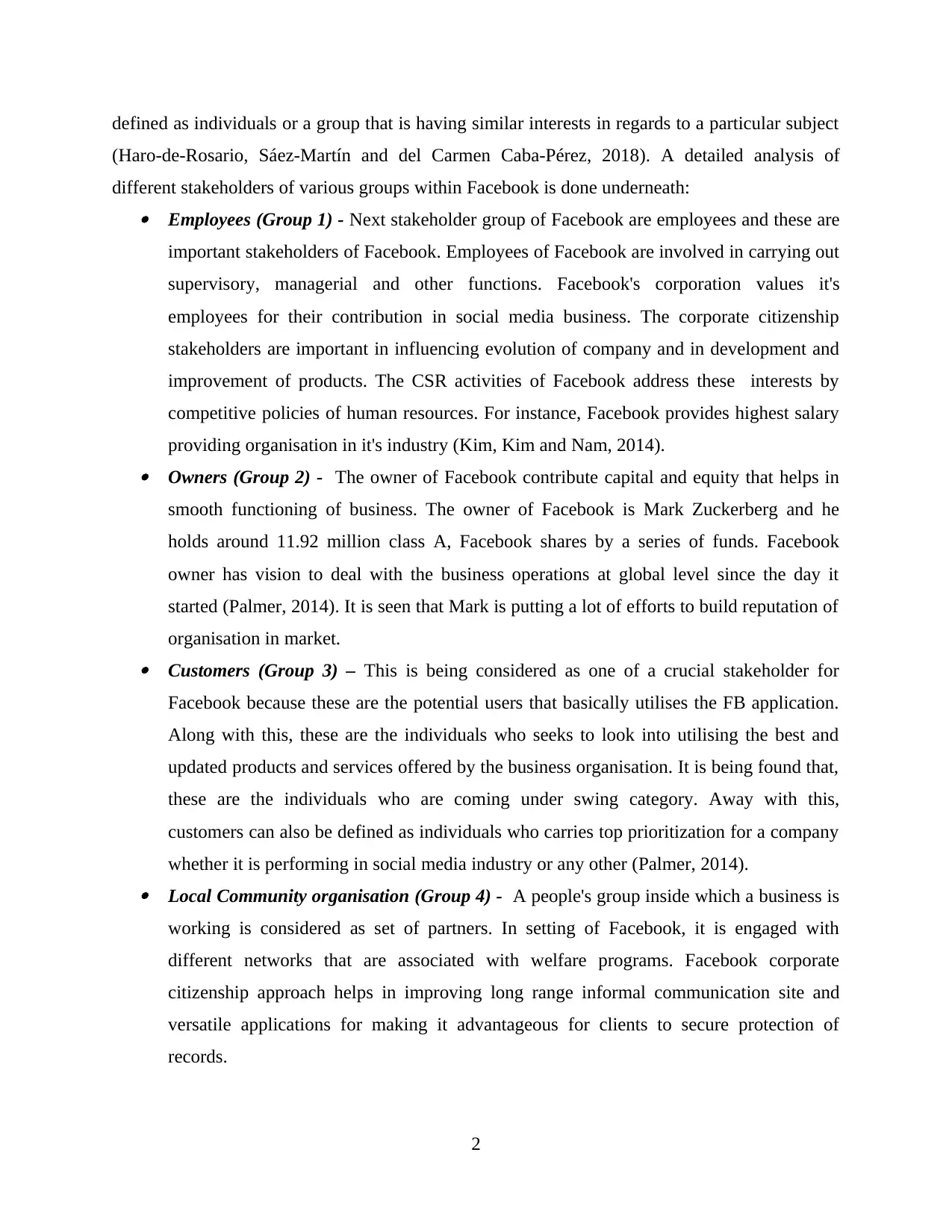
defined as individuals or a group that is having similar interests in regards to a particular subject
(Haro-de-Rosario, Sáez-Martín and del Carmen Caba-Pérez, 2018). A detailed analysis of
different stakeholders of various groups within Facebook is done underneath: Employees (Group 1) - Next stakeholder group of Facebook are employees and these are
important stakeholders of Facebook. Employees of Facebook are involved in carrying out
supervisory, managerial and other functions. Facebook's corporation values it's
employees for their contribution in social media business. The corporate citizenship
stakeholders are important in influencing evolution of company and in development and
improvement of products. The CSR activities of Facebook address these interests by
competitive policies of human resources. For instance, Facebook provides highest salary
providing organisation in it's industry (Kim, Kim and Nam, 2014). Owners (Group 2) - The owner of Facebook contribute capital and equity that helps in
smooth functioning of business. The owner of Facebook is Mark Zuckerberg and he
holds around 11.92 million class A, Facebook shares by a series of funds. Facebook
owner has vision to deal with the business operations at global level since the day it
started (Palmer, 2014). It is seen that Mark is putting a lot of efforts to build reputation of
organisation in market. Customers (Group 3) – This is being considered as one of a crucial stakeholder for
Facebook because these are the potential users that basically utilises the FB application.
Along with this, these are the individuals who seeks to look into utilising the best and
updated products and services offered by the business organisation. It is being found that,
these are the individuals who are coming under swing category. Away with this,
customers can also be defined as individuals who carries top prioritization for a company
whether it is performing in social media industry or any other (Palmer, 2014). Local Community organisation (Group 4) - A people's group inside which a business is
working is considered as set of partners. In setting of Facebook, it is engaged with
different networks that are associated with welfare programs. Facebook corporate
citizenship approach helps in improving long range informal communication site and
versatile applications for making it advantageous for clients to secure protection of
records.
2
(Haro-de-Rosario, Sáez-Martín and del Carmen Caba-Pérez, 2018). A detailed analysis of
different stakeholders of various groups within Facebook is done underneath: Employees (Group 1) - Next stakeholder group of Facebook are employees and these are
important stakeholders of Facebook. Employees of Facebook are involved in carrying out
supervisory, managerial and other functions. Facebook's corporation values it's
employees for their contribution in social media business. The corporate citizenship
stakeholders are important in influencing evolution of company and in development and
improvement of products. The CSR activities of Facebook address these interests by
competitive policies of human resources. For instance, Facebook provides highest salary
providing organisation in it's industry (Kim, Kim and Nam, 2014). Owners (Group 2) - The owner of Facebook contribute capital and equity that helps in
smooth functioning of business. The owner of Facebook is Mark Zuckerberg and he
holds around 11.92 million class A, Facebook shares by a series of funds. Facebook
owner has vision to deal with the business operations at global level since the day it
started (Palmer, 2014). It is seen that Mark is putting a lot of efforts to build reputation of
organisation in market. Customers (Group 3) – This is being considered as one of a crucial stakeholder for
Facebook because these are the potential users that basically utilises the FB application.
Along with this, these are the individuals who seeks to look into utilising the best and
updated products and services offered by the business organisation. It is being found that,
these are the individuals who are coming under swing category. Away with this,
customers can also be defined as individuals who carries top prioritization for a company
whether it is performing in social media industry or any other (Palmer, 2014). Local Community organisation (Group 4) - A people's group inside which a business is
working is considered as set of partners. In setting of Facebook, it is engaged with
different networks that are associated with welfare programs. Facebook corporate
citizenship approach helps in improving long range informal communication site and
versatile applications for making it advantageous for clients to secure protection of
records.
2
Paraphrase This Document
Need a fresh take? Get an instant paraphrase of this document with our AI Paraphraser
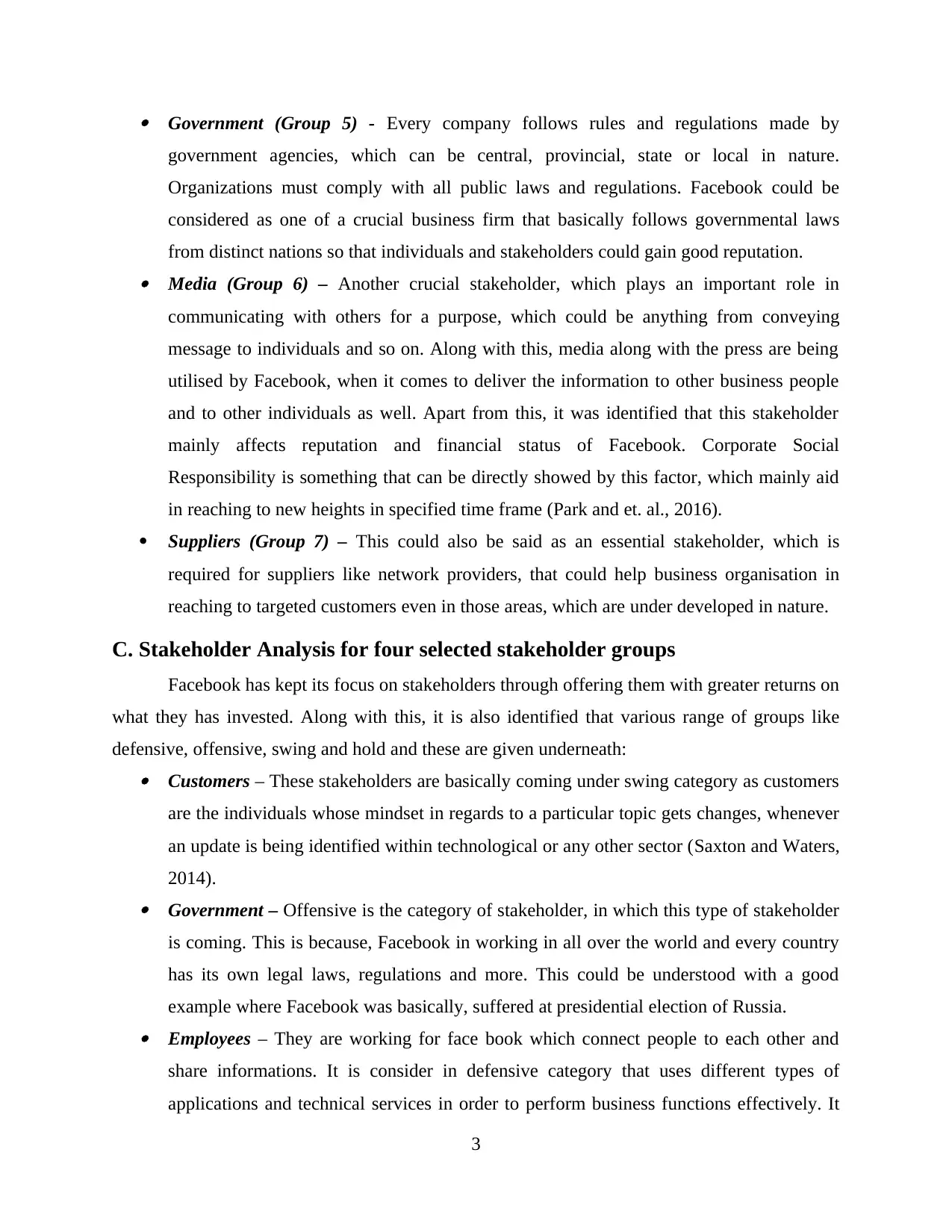
Government (Group 5) - Every company follows rules and regulations made by
government agencies, which can be central, provincial, state or local in nature.
Organizations must comply with all public laws and regulations. Facebook could be
considered as one of a crucial business firm that basically follows governmental laws
from distinct nations so that individuals and stakeholders could gain good reputation. Media (Group 6) – Another crucial stakeholder, which plays an important role in
communicating with others for a purpose, which could be anything from conveying
message to individuals and so on. Along with this, media along with the press are being
utilised by Facebook, when it comes to deliver the information to other business people
and to other individuals as well. Apart from this, it was identified that this stakeholder
mainly affects reputation and financial status of Facebook. Corporate Social
Responsibility is something that can be directly showed by this factor, which mainly aid
in reaching to new heights in specified time frame (Park and et. al., 2016).
Suppliers (Group 7) – This could also be said as an essential stakeholder, which is
required for suppliers like network providers, that could help business organisation in
reaching to targeted customers even in those areas, which are under developed in nature.
C. Stakeholder Analysis for four selected stakeholder groups
Facebook has kept its focus on stakeholders through offering them with greater returns on
what they has invested. Along with this, it is also identified that various range of groups like
defensive, offensive, swing and hold and these are given underneath: Customers – These stakeholders are basically coming under swing category as customers
are the individuals whose mindset in regards to a particular topic gets changes, whenever
an update is being identified within technological or any other sector (Saxton and Waters,
2014). Government – Offensive is the category of stakeholder, in which this type of stakeholder
is coming. This is because, Facebook in working in all over the world and every country
has its own legal laws, regulations and more. This could be understood with a good
example where Facebook was basically, suffered at presidential election of Russia. Employees – They are working for face book which connect people to each other and
share informations. It is consider in defensive category that uses different types of
applications and technical services in order to perform business functions effectively. It
3
government agencies, which can be central, provincial, state or local in nature.
Organizations must comply with all public laws and regulations. Facebook could be
considered as one of a crucial business firm that basically follows governmental laws
from distinct nations so that individuals and stakeholders could gain good reputation. Media (Group 6) – Another crucial stakeholder, which plays an important role in
communicating with others for a purpose, which could be anything from conveying
message to individuals and so on. Along with this, media along with the press are being
utilised by Facebook, when it comes to deliver the information to other business people
and to other individuals as well. Apart from this, it was identified that this stakeholder
mainly affects reputation and financial status of Facebook. Corporate Social
Responsibility is something that can be directly showed by this factor, which mainly aid
in reaching to new heights in specified time frame (Park and et. al., 2016).
Suppliers (Group 7) – This could also be said as an essential stakeholder, which is
required for suppliers like network providers, that could help business organisation in
reaching to targeted customers even in those areas, which are under developed in nature.
C. Stakeholder Analysis for four selected stakeholder groups
Facebook has kept its focus on stakeholders through offering them with greater returns on
what they has invested. Along with this, it is also identified that various range of groups like
defensive, offensive, swing and hold and these are given underneath: Customers – These stakeholders are basically coming under swing category as customers
are the individuals whose mindset in regards to a particular topic gets changes, whenever
an update is being identified within technological or any other sector (Saxton and Waters,
2014). Government – Offensive is the category of stakeholder, in which this type of stakeholder
is coming. This is because, Facebook in working in all over the world and every country
has its own legal laws, regulations and more. This could be understood with a good
example where Facebook was basically, suffered at presidential election of Russia. Employees – They are working for face book which connect people to each other and
share informations. It is consider in defensive category that uses different types of
applications and technical services in order to perform business functions effectively. It
3
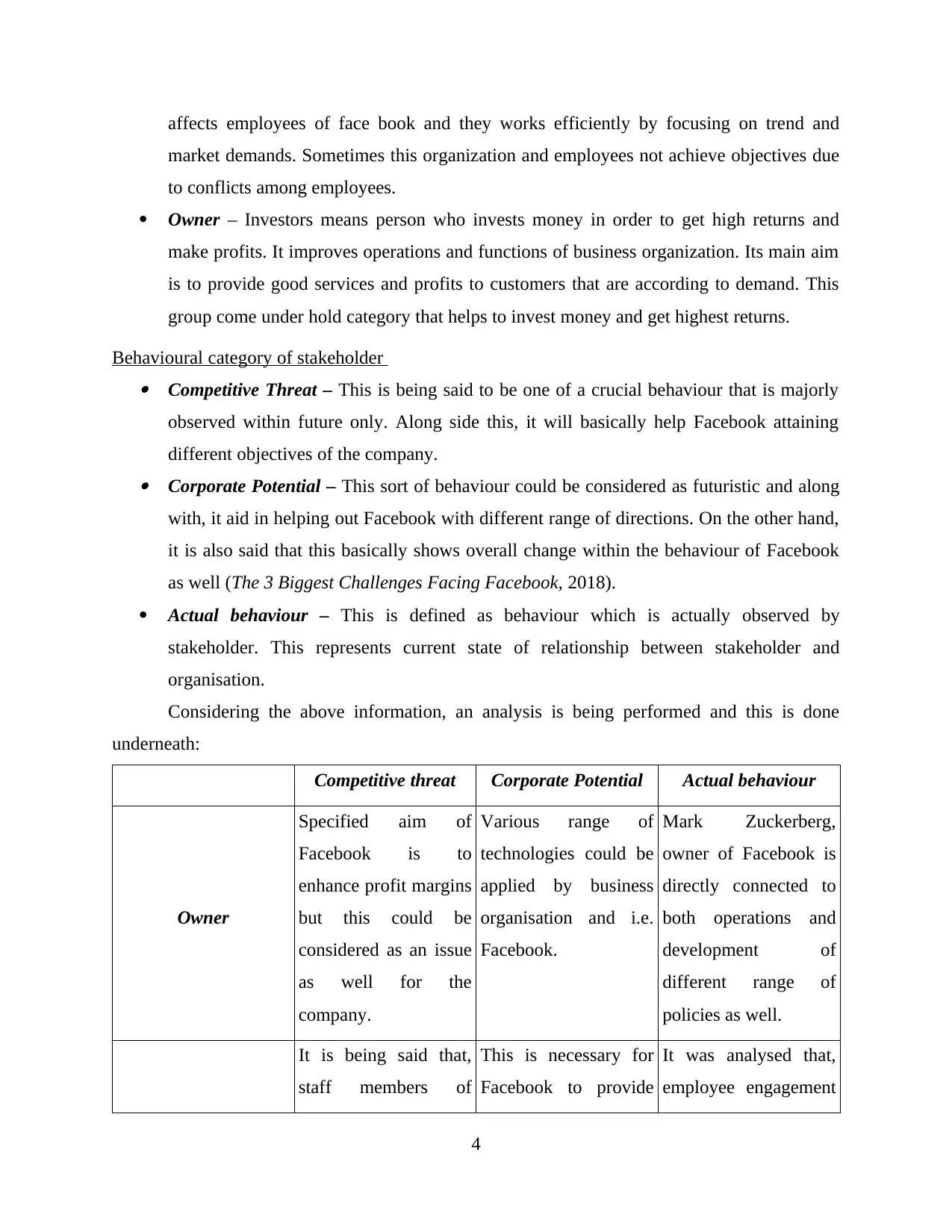
affects employees of face book and they works efficiently by focusing on trend and
market demands. Sometimes this organization and employees not achieve objectives due
to conflicts among employees.
Owner – Investors means person who invests money in order to get high returns and
make profits. It improves operations and functions of business organization. Its main aim
is to provide good services and profits to customers that are according to demand. This
group come under hold category that helps to invest money and get highest returns.
Behavioural category of stakeholder Competitive Threat – This is being said to be one of a crucial behaviour that is majorly
observed within future only. Along side this, it will basically help Facebook attaining
different objectives of the company. Corporate Potential – This sort of behaviour could be considered as futuristic and along
with, it aid in helping out Facebook with different range of directions. On the other hand,
it is also said that this basically shows overall change within the behaviour of Facebook
as well (The 3 Biggest Challenges Facing Facebook, 2018).
Actual behaviour – This is defined as behaviour which is actually observed by
stakeholder. This represents current state of relationship between stakeholder and
organisation.
Considering the above information, an analysis is being performed and this is done
underneath:
Competitive threat Corporate Potential Actual behaviour
Owner
Specified aim of
Facebook is to
enhance profit margins
but this could be
considered as an issue
as well for the
company.
Various range of
technologies could be
applied by business
organisation and i.e.
Facebook.
Mark Zuckerberg,
owner of Facebook is
directly connected to
both operations and
development of
different range of
policies as well.
It is being said that,
staff members of
This is necessary for
Facebook to provide
It was analysed that,
employee engagement
4
market demands. Sometimes this organization and employees not achieve objectives due
to conflicts among employees.
Owner – Investors means person who invests money in order to get high returns and
make profits. It improves operations and functions of business organization. Its main aim
is to provide good services and profits to customers that are according to demand. This
group come under hold category that helps to invest money and get highest returns.
Behavioural category of stakeholder Competitive Threat – This is being said to be one of a crucial behaviour that is majorly
observed within future only. Along side this, it will basically help Facebook attaining
different objectives of the company. Corporate Potential – This sort of behaviour could be considered as futuristic and along
with, it aid in helping out Facebook with different range of directions. On the other hand,
it is also said that this basically shows overall change within the behaviour of Facebook
as well (The 3 Biggest Challenges Facing Facebook, 2018).
Actual behaviour – This is defined as behaviour which is actually observed by
stakeholder. This represents current state of relationship between stakeholder and
organisation.
Considering the above information, an analysis is being performed and this is done
underneath:
Competitive threat Corporate Potential Actual behaviour
Owner
Specified aim of
Facebook is to
enhance profit margins
but this could be
considered as an issue
as well for the
company.
Various range of
technologies could be
applied by business
organisation and i.e.
Facebook.
Mark Zuckerberg,
owner of Facebook is
directly connected to
both operations and
development of
different range of
policies as well.
It is being said that,
staff members of
This is necessary for
Facebook to provide
It was analysed that,
employee engagement
4
⊘ This is a preview!⊘
Do you want full access?
Subscribe today to unlock all pages.

Trusted by 1+ million students worldwide
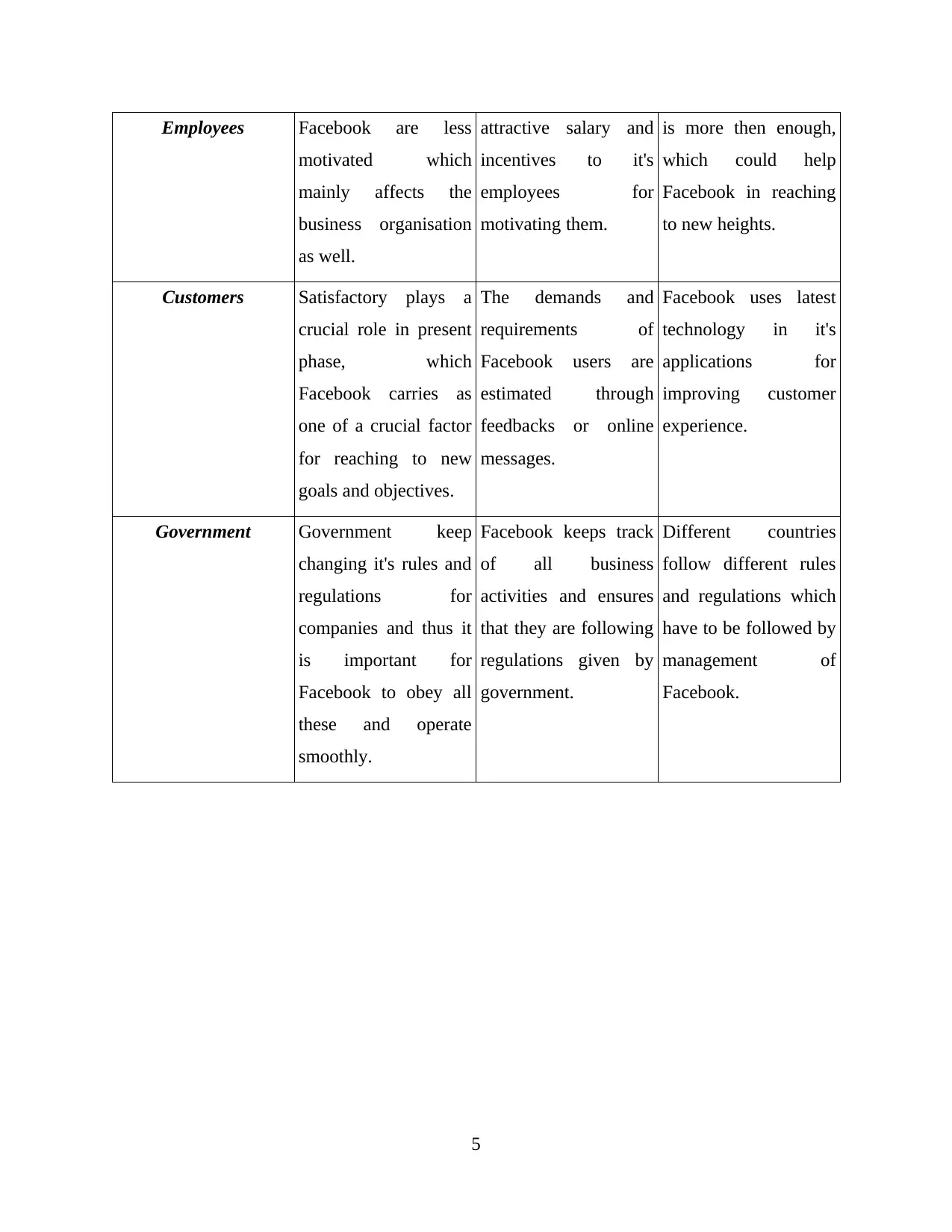
Employees Facebook are less
motivated which
mainly affects the
business organisation
as well.
attractive salary and
incentives to it's
employees for
motivating them.
is more then enough,
which could help
Facebook in reaching
to new heights.
Customers Satisfactory plays a
crucial role in present
phase, which
Facebook carries as
one of a crucial factor
for reaching to new
goals and objectives.
The demands and
requirements of
Facebook users are
estimated through
feedbacks or online
messages.
Facebook uses latest
technology in it's
applications for
improving customer
experience.
Government Government keep
changing it's rules and
regulations for
companies and thus it
is important for
Facebook to obey all
these and operate
smoothly.
Facebook keeps track
of all business
activities and ensures
that they are following
regulations given by
government.
Different countries
follow different rules
and regulations which
have to be followed by
management of
Facebook.
5
motivated which
mainly affects the
business organisation
as well.
attractive salary and
incentives to it's
employees for
motivating them.
is more then enough,
which could help
Facebook in reaching
to new heights.
Customers Satisfactory plays a
crucial role in present
phase, which
Facebook carries as
one of a crucial factor
for reaching to new
goals and objectives.
The demands and
requirements of
Facebook users are
estimated through
feedbacks or online
messages.
Facebook uses latest
technology in it's
applications for
improving customer
experience.
Government Government keep
changing it's rules and
regulations for
companies and thus it
is important for
Facebook to obey all
these and operate
smoothly.
Facebook keeps track
of all business
activities and ensures
that they are following
regulations given by
government.
Different countries
follow different rules
and regulations which
have to be followed by
management of
Facebook.
5
Paraphrase This Document
Need a fresh take? Get an instant paraphrase of this document with our AI Paraphraser
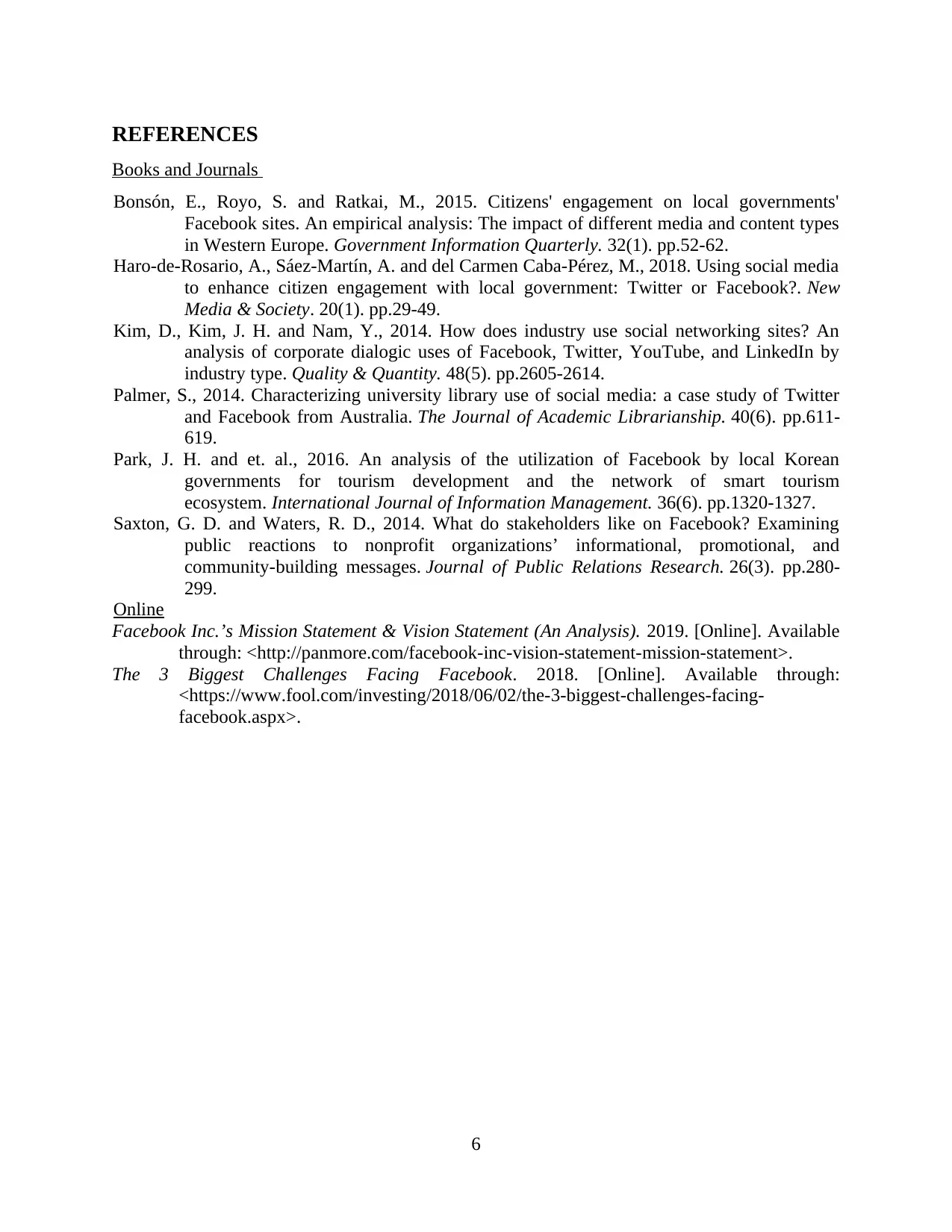
REFERENCES
Books and Journals
Bonsón, E., Royo, S. and Ratkai, M., 2015. Citizens' engagement on local governments'
Facebook sites. An empirical analysis: The impact of different media and content types
in Western Europe. Government Information Quarterly. 32(1). pp.52-62.
Haro-de-Rosario, A., Sáez-Martín, A. and del Carmen Caba-Pérez, M., 2018. Using social media
to enhance citizen engagement with local government: Twitter or Facebook?. New
Media & Society. 20(1). pp.29-49.
Kim, D., Kim, J. H. and Nam, Y., 2014. How does industry use social networking sites? An
analysis of corporate dialogic uses of Facebook, Twitter, YouTube, and LinkedIn by
industry type. Quality & Quantity. 48(5). pp.2605-2614.
Palmer, S., 2014. Characterizing university library use of social media: a case study of Twitter
and Facebook from Australia. The Journal of Academic Librarianship. 40(6). pp.611-
619.
Park, J. H. and et. al., 2016. An analysis of the utilization of Facebook by local Korean
governments for tourism development and the network of smart tourism
ecosystem. International Journal of Information Management. 36(6). pp.1320-1327.
Saxton, G. D. and Waters, R. D., 2014. What do stakeholders like on Facebook? Examining
public reactions to nonprofit organizations’ informational, promotional, and
community-building messages. Journal of Public Relations Research. 26(3). pp.280-
299.
Online
Facebook Inc.’s Mission Statement & Vision Statement (An Analysis). 2019. [Online]. Available
through: <http://panmore.com/facebook-inc-vision-statement-mission-statement>.
The 3 Biggest Challenges Facing Facebook. 2018. [Online]. Available through:
<https://www.fool.com/investing/2018/06/02/the-3-biggest-challenges-facing-
facebook.aspx>.
6
Books and Journals
Bonsón, E., Royo, S. and Ratkai, M., 2015. Citizens' engagement on local governments'
Facebook sites. An empirical analysis: The impact of different media and content types
in Western Europe. Government Information Quarterly. 32(1). pp.52-62.
Haro-de-Rosario, A., Sáez-Martín, A. and del Carmen Caba-Pérez, M., 2018. Using social media
to enhance citizen engagement with local government: Twitter or Facebook?. New
Media & Society. 20(1). pp.29-49.
Kim, D., Kim, J. H. and Nam, Y., 2014. How does industry use social networking sites? An
analysis of corporate dialogic uses of Facebook, Twitter, YouTube, and LinkedIn by
industry type. Quality & Quantity. 48(5). pp.2605-2614.
Palmer, S., 2014. Characterizing university library use of social media: a case study of Twitter
and Facebook from Australia. The Journal of Academic Librarianship. 40(6). pp.611-
619.
Park, J. H. and et. al., 2016. An analysis of the utilization of Facebook by local Korean
governments for tourism development and the network of smart tourism
ecosystem. International Journal of Information Management. 36(6). pp.1320-1327.
Saxton, G. D. and Waters, R. D., 2014. What do stakeholders like on Facebook? Examining
public reactions to nonprofit organizations’ informational, promotional, and
community-building messages. Journal of Public Relations Research. 26(3). pp.280-
299.
Online
Facebook Inc.’s Mission Statement & Vision Statement (An Analysis). 2019. [Online]. Available
through: <http://panmore.com/facebook-inc-vision-statement-mission-statement>.
The 3 Biggest Challenges Facing Facebook. 2018. [Online]. Available through:
<https://www.fool.com/investing/2018/06/02/the-3-biggest-challenges-facing-
facebook.aspx>.
6
1 out of 8
Related Documents
Your All-in-One AI-Powered Toolkit for Academic Success.
+13062052269
info@desklib.com
Available 24*7 on WhatsApp / Email
![[object Object]](/_next/static/media/star-bottom.7253800d.svg)
Unlock your academic potential
Copyright © 2020–2025 A2Z Services. All Rights Reserved. Developed and managed by ZUCOL.





